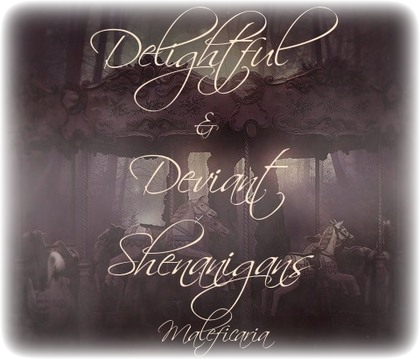Salem Massachusetts is known mostly for it's extreme deaths during the Salem Witch Trials which started in the late 1600's. People, women, men, children, and animals were wrongly accused and executed for something that in today's world is widely accepted, the practice of witchcraft (so recognized that a service member in the U.S. Military is able to claim "Wiccan" as their religion). They were burned, drowned, hung, pressed with stone weights, and even beaten for the accusation of being a witch. According to records, twenty-four people had died, nineteen of them hung at the Gallows Hill in Salem Town, while several died awaiting trial.

Examination of a Witch, by T.H. Matteson 1853.
Found at the Peabody Essex Museum
There were examinations that occurred to determine if a person was a witch. They associated birth marks or moles to be the mark of a witch or a mark given to a witch by the Devil. They believed that all witches served and obeyed Satan as well as did his bidding's by selling their souls for a favor granted by Satan/the Devil.
Judge Jonathan Corwin was, at that time, the local magistrate and civic leader who served on the Court of Oyer and Terminer that had ordered the hanging of the nineteen victims who were innocent of the charges that were brought against them. His home, later referred to as the "Witch House" was were these examinations took place. To this day, that is the only remaining structure left that was apart of the Salem Witch Trials. In 1948 the "Witch House" became a historical museum with the help of the concerned citizens when the town was going to demolish it. They raised the $42,500 needed to restore the house as well as move it to make way for the restoration of the town of Salem.
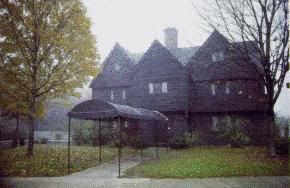
The Witch House, which is located at the corner of North and Essex Streets in Salem, MA.
There was one man, Giles Corey, who refused to plead guilty and was said to refuse to stand trial who was ultimately pressed to death- meaning there were stone weights placed upon his body for two days and he was slowly crushed to death by them. He lived for two days with those weights slowly crushing his body. Brutal, but later he was found innocent in the claims that were brought against him, much like the others who were murdered during the trials.
There are a total of 552 original documents pertaining to the witchcraft trials which have been preserved and are still stored by the Peabody Essex Museum. You are able to go to the Museum and see these documents through glass cases. There are also other things found to be used during the Witch Trials that are located at the Clerk's Office in the Essec Superior Court House, Salem, MA which include memorabilia of "Witch Pins" used during the examinations of "Witches" as well as a bottle that is said to contain the finger bones of one of the victims, George Jacobs, just to name a few.
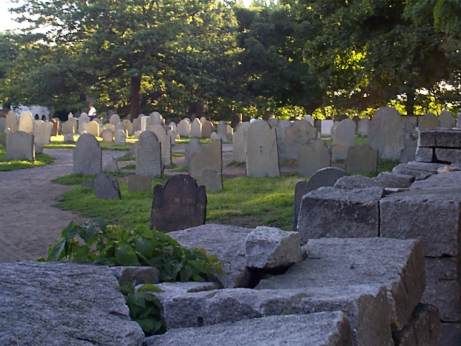
The TerCentenary Memorial in Salem, MA.
In August 1992 there was a TerCentenary Memorial dedicated to the Salem Witch Trials, by Nobel Laureate Elie Wiesel, which can be found adjacent to the Charter Street Old Burying Point. The Burying Point is the oldest known burial ground in Salem. It is here where the Justice John Hawthorne, an ancestor of author Nathaniel Hawthorne, and one other judge from the Witchcraft Court is said to be buried.
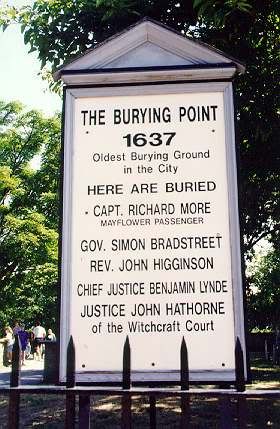
Across from the Burying Point and the Witch Trials Memorial is the Salem Wax Museum of Witches and Seafarers which houses London-made wax figures to show you what it was like living throughout Salem's historical past. The even do year round "Witch Tours" that bring people to the different points of where the Trials took place, where the accused and the accusers lived, as well as where the "death sentences" took place. They go into detail on what happened, who accused who, and what the ultimatum was for those found guilty of Witchcraft.
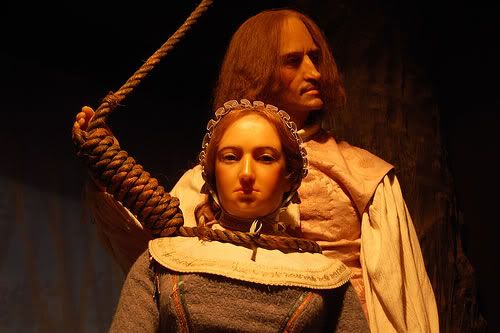
This is a wax figure showing a Witch just before her hanging
According to records these were some of the last words spoken by the victims who were falsely accused of being a witch and murdered for their "devilish actions":
June 10th, 1692:
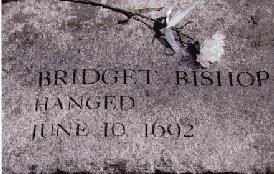
Bridget Bishop; Hanged
"I am no witch.
I am innocent.
I know nothing of it."
July 19, 1692
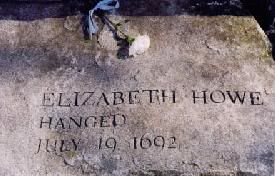
Elizabeth Howe; Hanged
"If it was the last moment I was to live,
God knows I am innocent..."
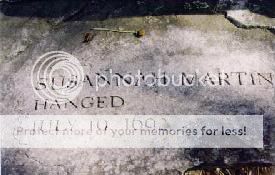
Susannah Martin; Hanged
"I have no hand in witchcraft."
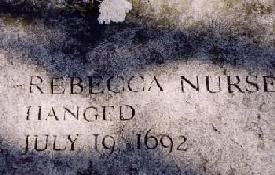
Rebecca Nurse; Hanged
"Oh Lord, help me! It is false. I am clear. For my life now lies in your hands...."
August 19, 1692
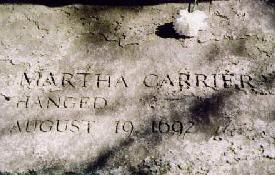
Martha Carrier; Hanged
"...I am wronged. It is a shameful thing that
you should mind these folks that are out of
their wits."
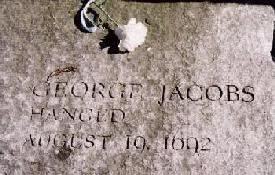
George Jacobs; Hanged
"Because I am falsely accused.
I never did it."
September 22, 1692
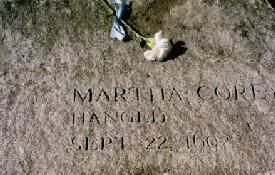
Martha Corey
"Ye are all against me..."
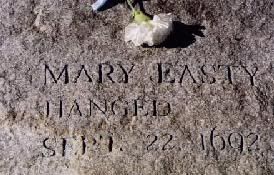
Mary Easty; Hanged
"If it be possible no more innocent
blood be shed...
...I am clear of this sin."
This is the chronology of the events as they transpired:
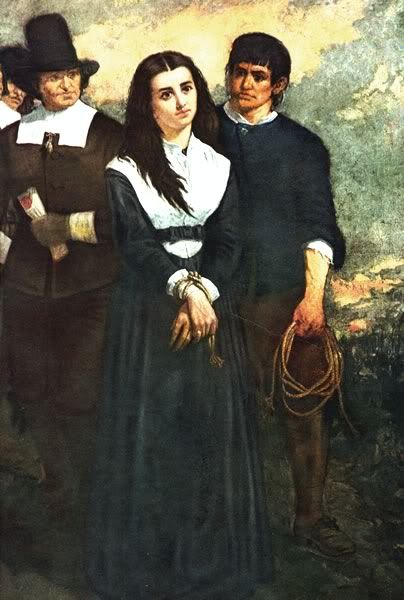
A short questioning of Sarah Good (Dialogue based on the examination of Sarah Good by Judges Hathorne and Corwin, from The Salem Witchcraft Papers, Book II, p.355)
What evil spirit have you familiarity with?
None.
Have you made no contract with the devil?
No.
Why do you hurt these children?
I do not hurt them. I scorn it.
Who do you imploy then to do it?
I imploy no body.
What creature do you imploy then?
No creature. I am falsely accused.
January 20
Nine-year-old Elizabeth Parris and eleven-year-old Abigail Williams began to exhibit strange behavior, such as blasphemous screaming, convulsive seizures, trance-like states and mysterious spells. Within a short time, several other Salem girls began to demonstrate similar behavior.
Mid-February
Unable to determine any physical cause for the symptoms and dreadful behavior, physicians concluded that the girls were under the influence of Satan.
Late February
Prayer services and community fasting were conducted by Reverend Samuel Parris in hopes of relieving the evil forces that plagued them. In an effort to expose the "witches", John Indian baked a witch cake made with rye meal and the afflicted girls' urine. This counter-magic was meant to reveal the identities of the "witches" to the afflicted girls.
Pressured to identify the source of their affliction, the girls named three women, including Tituba, Parris' Carib Indian slave, as witches. On February 29, warrants were issued for the arrests of Tituba, Sarah Good and Sarah Osborne.
Although Osborne and Good maintained innocence, Tituba confessed to seeing the devil who appeared to her "sometimes like a hog and sometimes like a great dog". What's more, Tituba testified that there was a conspiracy of witches at work in Salem.
March 1
Magistrates John Hathorne and Jonathan Corwin examined Tituba, Sarah Good, and Sarah Osborne in the meeting house in Salem Village. Tituba confessed to practicing witchcraft.
Over the next weeks, other townspeople came forward and testified that they, too, had been harmed by or had seen strange apparitions of some of the community members. As the witch hunt continued, accusations were made against many different people.
Frequently denounced were women whose behavior or economic circumstances were somehow disturbing to the social order and conventions of the time. Some of the accused had previous records of criminal activity, including witchcraft, but others were faithful churchgoers and people of high standing in the community.
March 12
Martha Corey is accused of witchcraft.
March 19
Rebecca Nurse was denounced as a witch.
March 21
Martha Corey was examined before Magistrates Hathorne and Corwin.
March 24
Rebecca Nurse was examined before Magistrates Hathorne and Corwin.
March 28
Elizabeth Proctor was denounced as a witch.
April 3
Sarah Cloyce, Rebecca Nurse's sister, was accused of witchcraft.
April 11
Elizabeth Proctor and Sarah Cloyce were examined before Hathorne, Corwin, Deputy Governor Thomas Danforth, and Captain Samuel Sewall. During this examination, John Proctor was also accused and imprisoned.
April 19
Abigail Hobbs, Bridget Bishop, Giles Corey, and Mary Warren were examined. Only Abigail Hobbs confessed.
William Hobbs
"I can deny it to my dying day."
April 22
Nehemiah Abbott, William and Deliverance Hobbs, Edward and Sarah Bishop, Mary Easty, Mary Black, Sarah Wildes, and Mary English were examined before Hathorne and Corwin. Only Nehemiah Abbott was cleared of charges.
May 2
Sarah Morey, Lydia Dustin, Susannah Martin, and Dorcas Hoar were examined by Hathorne and Corwin.
Dorcas Hoar
"I will speak the truth as long as I live."
May 4
George Burroughs was arrested in Wells, Maine.
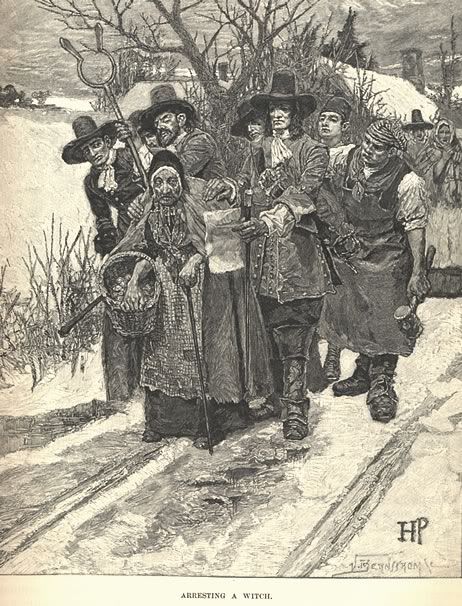
(The arresting of a Witch)
May 9
Burroughs was examined by Hathorne, Corwin, Sewall, and William Stoughton. One of the afflicted girls, Sarah Churchill, was also examined.
May 10
George Jacobs, Sr. and his granddaughter Margaret were examined before Hathorne and Corwin. Margaret confessed and testified that her grandfather and George Burroughs were both witches.
Sarah Osborne died in prison in Boston.
Margaret Jacobs
"... They told me if I would not confess I should be put down into the dungeon and would be hanged, but if I would confess I should save my life."
May 14
Increase Mather returned from England, bringing with him a new charter and the new governor, Sir William Phips.
May 18
Mary Easty was released from prison. Yet, due to the outcries and protests of her accusers, she was arrested a second time.
May 27
Governor Phips set up a special Court of Oyer and Terminer comprised of seven judges to try the witchcraft cases. Appointed were Lieutenant Governor William Stoughton, Nathaniel Saltonstall, Bartholomew Gedney, Peter Sergeant, Samuel Sewall, Wait Still Winthrop, John Richards, John Hathorne, and Jonathan Corwin.
These magistrates based their judgments and evaluations on various kinds of intangible evidence, including direct confessions, supernatural attributes (such as "witchmarks"), and reactions of the afflicted girls. Spectral evidence, based on the assumption that the Devil could assume the "specter" of an innocent person, was relied upon despite its controversial nature.
May 31
Martha Carrier, John Alden, Wilmott Redd, Elizabeth Howe, and Phillip English were examined before Hathorne, Corwin, and Gedney.
June 2
Initial session of the Court of Oyer and Terminer. Bridget Bishop was the first to be pronounced guilty of witchcraft and condemned to death.
Early June
Soon after Bridget Bishop's trial, Nathaniel Saltonstall resigned from the court, dissatisfied with its proceedings.
June 10
Bridget Bishop was hanged in Salem, the first official execution of the Salem witch trials.
Bridget Bishop
"I am no witch. I am innocent. I know nothing of it."
Following her death, accusations of witchcraft escalated, but the trials were not unopposed. Several townspeople signed petitions on behalf of accused people they believed to be innocent.
June 29-30
Rebecca Nurse, Susannah Martin, Sarah Wildes, Sarah Good and Elizabeth Howe were tried for witchcraft and condemned.
Rebecca Nurse
"Oh Lord, help me! It is false. I am clear. For my life now lies in your hands...."
Mid-July
In an effort to expose the witches afflicting his life, Joseph Ballard of nearby Andover enlisted the aid of the accusing girls of Salem. This action marked the beginning of the Andover witch hunt.
July 19
Rebecca Nurse, Susannah Martin, Elizabeth Howe, Sarah Good, and Sarah Wildes were executed.
Elizabeth Howe
"If it was the last moment I was to live, God knows I am innocent..."
Susannah Martin
"I have no hand in witchcraft."
August 2-6
George Jacobs, Sr., Martha Carrier, George Burroughs, John and Elizabeth Proctor, and John Willard were tried for witchcraft and condemned.
Martha Carrier
"...I am wronged. It is a shameful thing that you should mind these folks that are out of their wits."
August 19
George Jacobs, Sr., Martha Carrier, George Burroughs, John Proctor, and John Willard were hanged on Gallows Hill.
George Jacobs
"Because I am falsely accused. I never did it."
September 9
Martha Corey, Mary Easty, Alice Parker, Ann Pudeator, Dorcas Hoar, and Mary Bradbury were tried and condemned.
Mary Bradbury
"I do plead not guilty. I am wholly innocent of such wickedness."
September 17
Margaret Scott, Wilmott Redd, Samuel Wardwell, Mary Parker, Abigail Faulkner, Rebecca Eames, Mary Lacy, Ann Foster, and Abigail Hobbs were tried and condemned.
September 19
Giles Corey was pressed to death for refusing a trial.
September 21
Dorcas Hoar was the first of those pleading innocent to confess. Her execution was delayed.
September 22
Martha Corey, Margaret Scott, Mary Easty, Alice Parker, Ann Pudeator, Wilmott Redd, Samuel Wardwell, and Mary Parker were hanged.
October 8
After 20 people had been executed in the Salem witch hunt, Thomas Brattle wrote a letter criticizing the witchcraft trials. This letter had great impact on Governor Phips, who ordered that reliance on spectral and intangible evidence no longer be allowed in trials.
October 29
Governor Phips dissolved the Court of Oyer and Terminer.
November 25
The General Court of the colony created the Superior Court to try the remaining witchcraft cases which took place in May, 1693. This time no one was convicted.
Mary Easty
"...if it be possible no more innocent blood be shed...
...I am clear of this sin."
(This chronology can be found at: http://www.salemweb.com/memorial/chronology.shtml)
Only one "Witch" truly confessed to the crimes brought against her, Tituba, who is one of the more known witches of the Trials. Many people accused the victims of acts they did not do, claimed to be possessed by the demonic forces in which the "Witches" controlled, and even went as far as acting as if they were being forcibly thrown to the floor, screamed out in pain, and spoke in an "unknown" language while the Trials went on.
After the Trials were stopped and "Witches" were no longer available for prosecution, there were accounts of where those who claimed a "Witch" attacked them had withdrawn their claims and some even went as far as admitting that they lied. The Judges even publicly apologized as well as the State stepping in and trying to salvage the situation to the best of their abilities at the time.
Present day Salem is still known for their abundance of Witches. There are multiple museums, memorials, and even 'townies' who would welcome the curious minds to explore their world. I have personally gone to Salem on many accounts, I have visited the museums and have even paid my respect to those victims who have lost their lives during a wrongful conviction. If you walk through the city of Salem you can feel the presence of what was and what is now: Acceptance.
There are those who, when you walk into the square, who would welcome you and wish you many blessings. The religion I follow is that of Asatru. I have gone there to Salem and have bought many things that have been blessed by a Witch and have even had a few conversations with them. They wish no one ill will and they are some of the kindest people I have ever met. They answer any questions that would arise and meet you with both a courtesy nature as well as a humbleness.
To look back at Salem's past and see how it has morphed into one of the most famous "Witch Corners" is amazing. To see how, in the late 1600's, a Witch was considered evil and given a death sentence to where, in the present day, a Witch is considered a friend, a business partner, and even in some instances, the midwife you would go to for a blessing before a birth to the safe delivery of your child is truly amazing.
I implore you, where ever you are, if you ever get the chance of traveling to Massachusetts, to make a stop in Salem, Massachusetts. Take the time to explore the richness of their history, the fruitfulness of their present, and to pay your respects to those whose lives were lost for a misunderstanding in the life of a Witch. It is truly a remarkable place, one where when you leave, you will leave with a sense of understanding and the calm feeling of knowing that you, the reader, the visitor, have given this town and it's occupants the chance to teach you something about themselves.
|





















